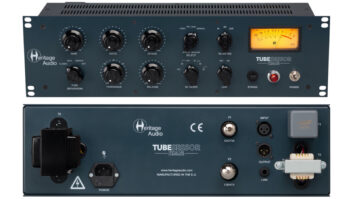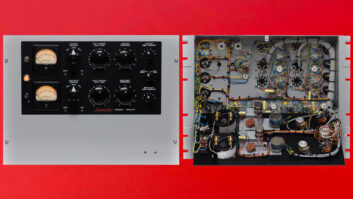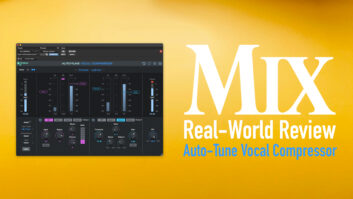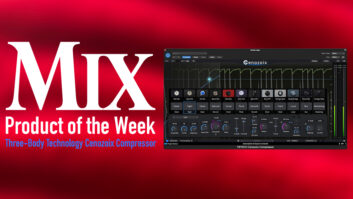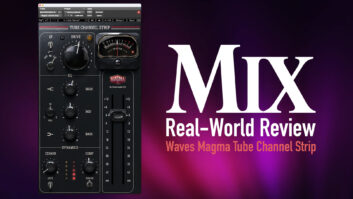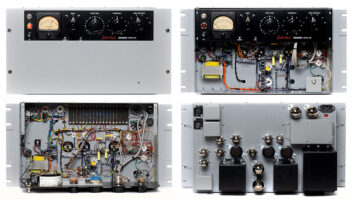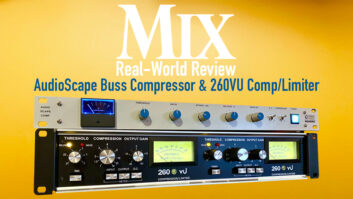
The Electro-Harmonix NY-2A vacuum tube compressor/limiter is impressive. Inside this $2,995 stereo unit is a mix of modern, retro and audiophile parts, some of which I’ve never seen before (such as TO-220-style power resistors mounted on heat sinks). If this product seems a stretch from a stomp box company that dates back to the Hendrix era, here are the connections. Electro-Harmonix was the brainchild of Mike Matthews, as is the parent company — New Sensor Corporation — the importer/owner of the EH, Sovtek and Svetlana brands of Russian-made vacuum tubes.
The three-rackspace front panel is clearly laid out with three variations on the photo-resistive theme. Traditional opto hardware converts sound to light using an electroluminescent panel driving the photo-resistive leg of a variable attenuator. The designer, J.C. Morrison, chose different attack and decay characteristics using LED and incandescent lamp drivers.
The lamp produces a unique range of colors depending on the amount of gain reduction. By centering my tests within a 6dB gain-reduction processing window, I could audition each “opto option” simply by rotating the electroluminescent-LED-incandescent switch. More than 6 dB of gain reduction and the LED moved beyond peak limiting and into compression where it is not well-suited. Electroluminescent was the most consistent no matter how much gain reduction was used.
Also on the front panel are squash and attack switches that, respectively, modify the electroluminescent and incandescent response. I kept these switches off most of the time, preferring to learn the native characteristics of each opto. Electroluminescent provides an obviously familiar blend of compression and limiting with minimal artifacts. LED is essentially a peak limiter, and as such, must be used sparingly because the gain reduction meter is not as fast as the opto. Incandescent has a slow, lagging attack time because it takes a while for the filament to glow, but then — snap! — it bites down and makes a kick drum pop out of a mix. Once the glow is gone, up comes the ambience until the threshold is triggered again.
There are three rotary controls (pre-gain, compress and post-gain) and no attack or release controls. Simple, just as optical should be.
The passive components are all first-rate. Low-noise, metal film resistors are standard in most gear, but multicaps for interstage coupling add the audiophile’s touch. The 105° centigrade electrolytic caps used for power supply de-coupling will withstand the heat this unit generates. (Multicaps are as the name implies: large values manufactured from up to 10 smaller value caps. High-temp electrolytic caps last longer in hot spaces than conventional caps.) Add to this the highly regarded Lundahl I/O transformers.
There are eight vacuum tubes — four per channel, three of which are in the signal path: a dual-triode on the front end, a single triode and a dual-triode for the output stage. All are Russian military-grade tubes. The fourth tube is the EM80 “magic eye” front panel output indicator, though its speed might be better suited to gain reduction duty when in LED mode. (The VU meter can read gain reduction or output.)
I primarily listened to three music genres through the NY-2A; minimally processed acoustic guitar-based Americana and unprocessed jazz worked best with electroluminescent processing. The LED did a nice job on some early-’80s rock, R&B and grunge, transforming an exaggerated low-end punch into a more modern sound. Incandescent will always be worth a try: It’s unlike anything you’ve ever heard, and yet it reminded me of a Neve 2254 as it seemed to enhance the kick drum. It might be well suited to lifeless raw kick tracks.
I modified this unit after using it for a day because each opto has a radically different threshold, a discrepancy that required two hands — one to reset the compress control, the other to select an opto. (The LED is most sensitive but should be the least sensitive.) My goal is the same as any A/B/X comparison process — to minimize any level discrepancies in order to judge only the actual differences. While this seemed annoying to me, EHX believes that the radical thresholds enhance each opto’s differences. However, I am fully capable of tickling for nuance as well as abusing for effect. I just want a “level” playing field to do that.
But the strength of the NY-2A is its sound. It delivers 23dBu out at about 0.5% distortion and 20 dBm into a 600-ohm load. (This unit must be terminated.) Signal-to-noise ballparks around 80 dB, depending on settings. This figure could probably be improved if the power supply was separately packaged. The Russian filaments draw more current than conventional tubes, so the power transformer is massive. Distortion at more nominal levels is closer to 0.1% with no processing, typical for a circuit design that does not have negative feedback. This allows a broad avenue of color between linear and clipping. When the unit is driven hard, the sound is more of a midrange grunge than that “cut glass” sound of op amps.
The NY-2A’s sound is 3-D. It has the spatial depth and fatness associated with vintage tube gear and their lovely transformers. Of course, there are many approaches to retro gear, from exact replicas to exciting hybrids. The NY-2A adheres to an audiophile discipline: using simple plate-loaded triode circuits (no cathode followers) and ultra-high quality (if not esoteric) components. Again, its simplicity is a plus. In three clicks, you’ll know if it can do the job or not. It is a compressor/limiter with a wide range of what I like to call “nuance headroom.” If you’re looking for an optical processor, the NY-2A is unique and tasty, with three flavors in one. No other opto-box can make that claim.
Electro-Harmonix, 718/937-8300, www.ehx.com.
